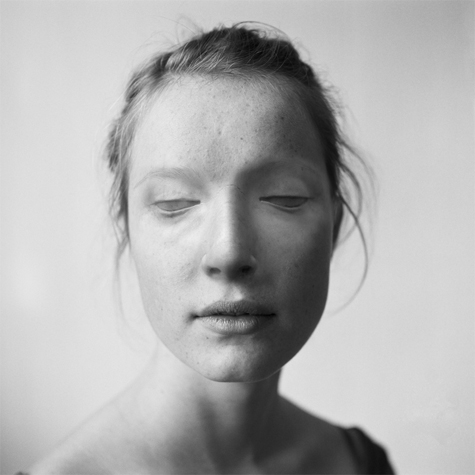Diane Ducruet, Hamburg, Germany / Paris, France
Passengers
The images from the series “Passengers” have been realized at the time I was living in Berlin from 2005 to 2007.
The back and forth in-between the different medias used in the project is build like an echo of a collective memory, stripped off some commemorative places or museums, in order to get lost within figures and places of the past."Passengers" get to the core this business, since one can’t separate marble and flesh, and does not know wether we are built or deconstructed, rotting or appearing. Simplicity of the scene, frontality, lecture in square, monochromy organize a silence of laboratory... A Rebirth is not so far, because finally we become again enigmas after one century of discoveries so terrible and so unexpected that we are frightened of ourselves.

Selfportraits
Since I started photography, my principal intention was to build a « visual territory », more than a work crystallized on specific topics.
"What is important for me, is always managing to catch what does not cease changing, and the problem is the same for a self-portrait or for the portrait of somebody else" Francis Bacon
"Goya was acquainted with demons and witches. You only have to look at his portrait of Charles IV and his degenerate family to burst out laughing at their majesties’ lamentably bloated faces. When an era ends, it disguises itself. Entertainment reaches the elite.
The court’ss photographers have a sense of entertainment, and contemporary entertainment never ends. How amusing it is to remember that the specialist of the unconscious and inventor of the libido, had a nephew who had an amazing career launching modern advertising in the USA . His name was Edward Bernays. Indeed, we needed such visionaries to drive the images of the past out of our minds, switching everything from Praxitelus to Picasso to packets of cigarettes, cars, movie stars and massacres. Images rove, where desires rove.
But as the convulsions or agony of humanism were not accepted by everybody, everywhere, photographers were advised to dress top models as Samothrace’s Victory, businessmen as cultivated men, intellectuals as prophets, gin bottles as uncut diamonds, mineral water as fountains of youth, sportsmen as knights, actors as authors, alcoholic actresses as figures of destiny, the women as pearl necklaces...
And once more the carnival continues, and the world of images called luxery passes a little like top models, with their twisted feet, hollow cheeks, and amazing swaying walk.
Diane Ducruet uses photography for something else.
What she’s showing is evident, but from the other side of the mirror.
Helmut Newton said that he photographed only appearances. He acknowledged his own self interest and used his fabulous talent for organizing light and shadow to announce his presence to the world to make us feel as he felt. His models let themselves be pulled into the adventure because they knew they would leave the usual path of their existence and be propelled into a game where seduction battles with obscenity. A woman spends half of her life never forgetting she can be an object; society wants her that way. Diane’s photographs are not these types of self-portraits or even less a proof of technical competency. They are also not a pretext to re-visit the world of images or more naively the history of art. Looking at her photographs, we are standing in front of quiet alternatives : This is not her looking at herself, but here are others she’s showing through.
As Goya made the Spanish queen become the witch of a political sabbath, Diane uses her body and being as a representation of the Sabbath of society. She shows life’s pastimes as fate. Diane becomes what nobody wants to see.
Those who can’t see themselves won’t see her. Because to be oneself, one also needs to be elsewhere. » Milou - About the «Selfportraits» - 2003








